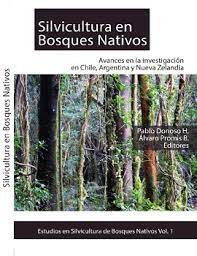Ver ítem
- xmlui.general.dspace_homeCentros Regionales y EEAsCentro Regional Patagonia SurEEA Santa CruzPartes de librosxmlui.ArtifactBrowser.ItemViewer.trail
- Inicio
- Centros Regionales y EEAs
- Centro Regional Patagonia Sur
- EEA Santa Cruz
- Partes de libros
- Ver ítem
La producción forestal y la conservación de la biodiversidad en los bosques de Nothofagus en Tierra del Fuego y Patagonia Sur
Resumen
Las propuestas de manejo forestal para Tierra del Fuego y Patagonia Sur se basan en el manejo silvopastoril para Nothofagus antarctica (ñire), y cortas de protección y raleo para Nothofagus pumilio (lenga). Ambas propuestas producen impactos sobre
los componentes bióticos y abióticos del bosque original. El objetivo de este capítulo es analizar las propuestas de manejo, planteando alternativas que prioricen el equilibrio entre producción y conservación a
[ver mas...]
Las propuestas de manejo forestal para Tierra del Fuego y Patagonia Sur se basan en el manejo silvopastoril para Nothofagus antarctica (ñire), y cortas de protección y raleo para Nothofagus pumilio (lenga). Ambas propuestas producen impactos sobre
los componentes bióticos y abióticos del bosque original. El objetivo de este capítulo es analizar las propuestas de manejo, planteando alternativas que prioricen el equilibrio entre producción y conservación a partir de las investigaciones actuales. Se analizan
diferentes escalas en la planificación del manejo forestal y estrategias de conservación (macro, meso y micro-escala), describiendo ventajas y costos incrementales de su aplicación. En particular, se describe la aplicación de la retención variable como técnica
complementaria de las cortas de protección, para minimizar los impactos de la cosecha a escala de rodal sobre las variables abióticas y bióticas. Asimismo, se analiza la regeneración natural como la variable de mayor importancia en los monitoreos postcosecha, junto con los factores limitantes del ciclo y la posterior dinámica en parcelas de investigación a largo plazo, así como los resultados de ensayos de raleos y podas comerciales. Finalmente, se describen las carencias en el conocimiento científico y
técnico desarrollado hasta el presente, a fin de mejorar la implementación del manejo forestal actual. A partir de este análisis se proponen diez desafíos a tener en cuenta para la próxima década. Summary: Forest management for Tierra del Fuego and southern Patagonia are based mainly on silvopastoral use of Nothofagus antarctica (ñire), and shelterwood cuts and thinnings for Nothofagus pumilio (lenga). Both proposals had impacts over biotic and abiotic components of the original forests. The objective of this chapter was to analyze these management practices by introducing a concept of equilibrium between timber production
and conservation. Different planning scales (macro-, meso- and micro-scale) were analyzed for forest management and conservation including advantages and implementation. In particular, variable retention implementation was described as complementary technique of the shelterwood cuts, where harvesting impacts over abiotic and biotic scale at stand level were minimized. Natural regeneration, as one of the most important variable in the post-harvesting monitoring, also was analyzed. Limiting factors in the whole reproductive cycle, their natural dynamics in long-term research plots, commercial thinnings and prunings were described. Finally, it was identified the main actual scientific and technical knowledge gaps in order to improve the future research and implementation in the current forest management.
[Cerrar]
Forest management for Tierra del Fuego and southern Patagonia are based mainly on silvopastoral use of Nothofagus antarctica (ñire), and shelterwood cuts and thinnings for Nothofagus pumilio (lenga). Both proposals had impacts over biotic and abiotic components of the original forests. The objective of this chapter was to analyze these management practices by introducing a concept of equilibrium between timber production
and conservation. Different
[ver mas...]
Forest management for Tierra del Fuego and southern Patagonia are based mainly on silvopastoral use of Nothofagus antarctica (ñire), and shelterwood cuts and thinnings for Nothofagus pumilio (lenga). Both proposals had impacts over biotic and abiotic components of the original forests. The objective of this chapter was to analyze these management practices by introducing a concept of equilibrium between timber production
and conservation. Different planning scales (macro-, meso- and micro-scale) were analyzed for forest management and conservation including advantages and implementation. In particular, variable retention implementation was described as complementary technique of the shelterwood cuts, where harvesting impacts over abiotic and biotic scale at stand level were minimized. Natural regeneration, as one of the most important variable in the post-harvesting monitoring, also was analyzed. Limiting factors in the whole reproductive cycle, their natural dynamics in long-term research plots, commercial thinnings and prunings were described. Finally, it was identified the main actual scientific and technical knowledge gaps in order to improve the future research and implementation in the current forest management.
[Cerrar]

Autor
Martinez Pastur, Guillermo José;
Peri, Pablo Luis;
Lencinas, María Vanessa;
Cellini, Juan Manuel;
Barrera, Marcelo Daniel;
Soler Esteban, Rosina Matilde;
Ivancich, Horacio Simón;
Mestre, Luciana;
Moretto, Alicia Susana;
Anderson, Christopher B.;
Pulido, Fernando;
Fuente
Silvicultura en Bosques Nativos: Avances en la investigación en Chile, Argentina y Nueva Zelanda / Eds. Donoso P. y Promis A. Universidad Austral de Chile, 2013. Capítulo 8, p. 171-197
Fecha
2013
Editorial
Universidad Austral de Chile
ISBN
978-956-7173-32-7
Formato
pdf
Tipo de documento
parte de libro
Palabras Claves
Derechos de acceso
Abierto
 Excepto donde se diga explicitamente, este item se publica bajo la siguiente descripción: Creative Commons Attribution-NonCommercial-ShareAlike 2.5 Unported (CC BY-NC-SA 2.5)
Excepto donde se diga explicitamente, este item se publica bajo la siguiente descripción: Creative Commons Attribution-NonCommercial-ShareAlike 2.5 Unported (CC BY-NC-SA 2.5)


